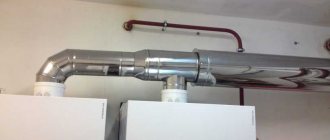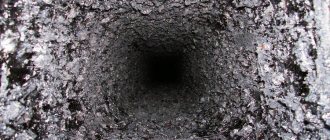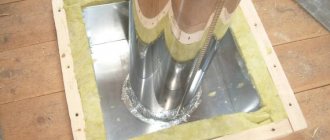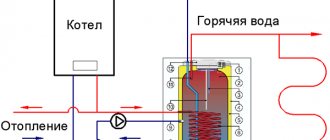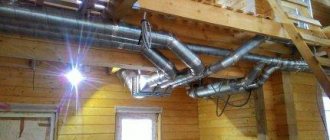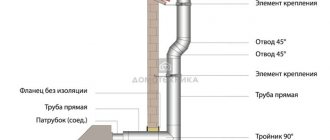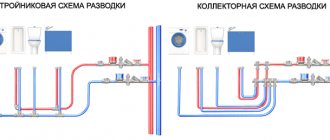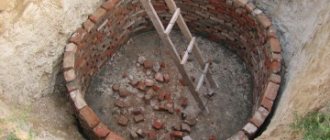Other articles on this topic:
⇒ Heating a private house with a solid fuel boiler ⇒ Solid fuel heating boiler with a heat accumulator - buffer tank
In new private houses equipped with heating boilers, traditional brick chimneys chimney systems made of steel or ceramics are also increasingly used
Which chimney should you choose? How to properly make a chimney for a boiler in a private house? Where to buy high-quality steel chimney pipes?
For a solid fuel boiler - a brick chimney
A brick chimney is usually cheaper
than modern chimney systems.
A traditional ceramic brick chimney pipe can easily withstand high flue gas temperatures. The pipe can even withstand the ignition of soot accumulations in the chimney .
A brick chimney for a boiler in a private house is a rather heavy structure. The chimney is placed on a foundation or solid reinforced concrete floor. The construction of such a chimney requires certain skills; it is better to entrust the laying of a sealed and durable chimney to a qualified stove mason.
Channels and chimneys and ventilation are often placed in a brick chimney
The chimney is laid from high-quality solid ceramic bricks of a grade not lower than M125 using ordinary masonry mortar. The upper section of the pipe, above the roof, can be laid out of facing or clinker bricks. The thickness of the chimney walls must be at least 120 mm (half a brick).
Brick chimney laying. Ventilation ducts are usually placed next to the chimney in one vertical block. Templates make it easier to lay even channels with smooth walls.
The size of the chimney and ventilation channels is chosen as a multiple of the brick size, taking into account the thickness of the vertical joints. For example, the channel cross-section can be 140x140 mm (1/2x1/2 brick) or 140x200 mm (1/2x3/4 brick), or 140x270 mm (1/2 x 1 brick). In practice, a smoke channel is often made measuring 20 x 20 cm (3/4 x 3/4 bricks). If necessary, it is easy to select and insert a round steel or ceramic liner of the appropriate diameter into such a channel.
The flue gases in the chimney duct should not be very cool. Therefore, they try to build the chimney into the masonry of the internal wall of the house or attach it to the wall. Sections of the chimney that pass through an unheated room (attic) or outside the house are insulated with mineral wool .
A brick chimney serves reliably and for a long time only at high flue gas temperatures,
which prevents condensation from forming in the pipe. As a rule, this condition is met when the chimney is operated with a conventional solid fuel boiler.
When working with modern gas or liquid fuel boilers, as well as with solid fuel pyrolysis boilers, pellet and others, operating for a long time in a slow burning mode of low intensity, the brick chimney is destroyed quite quickly.
Modern boilers are designed so that the exhaust gases have a fairly low temperature. As a result, condensation of water vapor contained in the flue gases occurs in the chimney. The pipe walls are constantly moistened. In addition, when combining with other combustion products, water forms aggressive chemical compounds on the inner surface of the pipe.
In particular, the exhaust gases of boilers contain sulfur, which, interacting with water, forms sulfuric acid in the chimney, which corrodes its walls. External signs of destruction are dark wet spots on the outer surface of the brick pipe.
The operating mode of a solid fuel pyrolysis boiler also contributes to the formation of aggressive condensate in the chimney, which quickly destroys the brick chimney.
Rough chimney walls contribute to the accumulation of solid soot particles on them. The roughness of the walls and the rectangular shape of the chimney duct make it difficult to clean the chimney from deposits.
To connect gas and other boilers with low exhaust gas temperatures to a brick chimney, an insert must be placed in the brick channel - a steel or ceramic chimney pipe .
A chimney made of ceramic pipes is a universal solution for a boiler in a private house
Chimneys made from special ceramic chimney pipes can be used for all types of boilers.
The material is resistant to high temperatures and to any aggressive chemical compounds that can form in the chimney during the combustion of different types of fuel.
This type of chimney is the most durable.
Ceramic chimney pipes are distinguished by the permissible maximum temperature of the exhaust gases.
For solid fuel boilers
Pipes with a permissible flue gas temperature of 600-650 °C should be used, resistant to the combustion of soot deposits in the pipe and designed to operate in a dry state.
For gas and liquid fuel boilers
they use ceramic chimney systems with a permissible gas temperature of 400-450 oC, designed for operation in a wet state - equipped with condensate drains.
The ceramic pipe and the thermal insulation around it absorb moisture and therefore must be ventilated from the outside.
The purpose and operating conditions of the chimney system are indicated in the attached manufacturer's documentation.
The smooth surface of the pipe and the round shape of the smoke channel ensure that the walls are resistant to contamination and easy to clean.
Conclusions and useful video on the topic
In the video below you will hear a reasoned opinion from a specialist on the use of different types of pipes for installing a heating system.
To perform boiler piping, you can use different types of pipes, for the optimal selection of which you should take into account a whole range of factors: features of the boiler and heating system, material capabilities, personal preferences.
If you have some qualifications, you can install plastic elements yourself, strictly following the diagram, but for installing metal pipes it is better to seek help from specialists.
Are you looking for high-quality pipes for piping your boiler? Or do you have experience in installing and using a certain pipe product? Please leave comments on the article, ask questions and participate in discussions. The contact form is located below.
Ceramic chimney design
The chimney is assembled from individual elements - ceramic pipes 600 - 1000 mm long, which are connected to each other using shaped parts at the ends and acid-resistant adhesive mastic.
Ceramic chimney section:
- ceramic pipe,
- insulation,
- shell made of concrete block modules with ventilation ducts and holes for vertical reinforcement.
Ceramic chimney pipes are usually placed in a specially laid vertical channel
from hollow building blocks or bricks. The chimney duct may be part of the ventilation unit of a private house.
For laying the shell, special concrete blocks with one, two or several voids are used. Other channels are used for ventilation of rooms or for supplying air to the burner of a boiler with a closed combustion chamber, or for laying communications.
The chimney pipe is usually insulated to protect surrounding structures from high temperatures.
To do this, mineral wool insulation is placed around the ceramic pipe.
In addition, insulation allows you to increase the temperature of the exhaust gases. Cooling the flue gases in the chimney increases the amount of condensation and reduces the natural draft in the chimney.
There are vertical air channels between the wall of the concrete shell and the insulation
for ventilation of insulation and ceramic chimney pipe.
A ceramic chimney, compared to a brick one, takes up less space, its installation from ready-made parts is faster and easier.
Concrete blocks have channels for installing reinforcement in them. Be sure to reinforce the part of the pipe that protrudes above the roof.
The construction market offers a variety of sets of parts and materials for the construction of ceramic chimneys for a boiler in a private house.
A ceramic chimney in a steel casing combines the advantages of ceramic chimneys (increased durability) with the advantages of steel chimneys (ease of installation in a residential building)
Ceramic chimney design options in a steel casing are available for sale.
- with an outer shell made of steel.
Such a chimney often does not require a foundation for its placement, and it also does not require special channels
in building structures. It can be installed almost anywhere, both inside and outside the house.
Chimney with ceramic liner in brickwork.
Some manufacturers produce rectangular ceramic sleeves specifically designed for embedding into brickwork.
Such a chimney can be a free-standing chimney or built into the masonry of a wall.
The construction length of square pipe sections can be 600 or 1000 mm. In this option, there is no need to buy special concrete blocks for constructing the chimney shell.
Ceramic chimney for a gas boiler with a closed combustion chamber
For gas boilers with a closed combustion chamber, coaxial, pipe-in-pipe, steel chimneys are popular, in which flue gases are removed through the inner pipe, and air from the street is supplied to the boiler through the outer pipe for combustion.
In the harsh Russian climate, problems often arise when operating a boiler with a coaxial chimney. In severe frosts, cold street air moving through the outer pipe greatly cools the inner pipe and the flue gases in it. Condensate falling from the flue gases freezes on the walls of the pipe, gradually clogging the chimney. The boiler automation reacts and turns off the boiler.
Fewer problems for the operation of a gas boiler are caused by chimneys with two separate channels: one for flue gases and the other for air into the burner.
The shell of a ceramic chimney for a gas boiler with a closed combustion chamber is assembled from concrete blocks with two channels. The insulated ceramic sleeve maintains the temperature of the flue gases, thanks to this, freezing of the chimney does not occur. Air is supplied to the boiler burner through a nearby channel.
Watch the video lesson on the topic “Design and installation of a ceramic chimney”:
Steel chimney
The steel chimney on the facade of the house should be in harmony with the architecture of the house and please the owner.
Steel chimney pipes for gas boilers
with a flue gas temperature of 400-450 °C, they are made of stainless steel with a thickness of 0.5-0.6 mm. Such pipes are quite resistant to aggressive condensate on the walls.
Heat-resistant steel pipes are used with solid fuel boilers
1.0 mm thick.
The service life of steel chimneys is much shorter, and their cost is usually higher than ceramic and brick ones.
But prefabricated steel chimneys are easier and faster to install, they are quite lightweight and do not require solid foundations or special channels in building structures for installation. Available for repair.
A steel chimney for a boiler in a private house is easy to assemble from ready-made elements with your own hands.
A steel chimney, like a ceramic one, is not inclined to accumulate dirt on its walls, and the surface of the walls is easy to clean.
Purchase
Where to buy a chimney for a boiler?
Now this can be done via the Internet. There are a huge number of sites on this topic. Where you can arrange a full range of services from consultation to installation. But you should choose carefully, focusing on large companies since they have a wider range of services provided.
Steel chimney installation
| Steel chimney pipes On the left, the sandwich is double-walled. Single wall - on the right. |
Steel chimneys are manufactured in several versions:
1. Steel single wall
the chimney pipe can be placed in a specially laid vertical channel of the building structure. The design of the chimney in this case is similar to the ceramic one (see above).
Products for construction and repair
⇆
2. A single-wall pipe is also used for reconstruction of a brick chimney,
adapting it to work with a gas boiler.
The single-wall steel chimney pipe is simply inserted from above into the brick pipe channel. For insertion into an existing brick pipe with a rectangular channel, oval-section steel pipes .
3. The chimney is assembled from prefabricated sections. The section is double-walled
sandwich - pipe. The chimney pipe is located inside another steel pipe - a protective casing, shell. The space between the pipe and the shell is filled with thermal insulation.
The outer pipe of the sandwich chimney is made of stainless or galvanized steel.
A steel fireplace chimney assembled from double-walled sandwich modules can serve as an impressive interior decoration.
They produce chimneys designed for installation both indoors and outdoors. The chimney is easily assembled, like a construction set, from individual sandwich modules.
The use of such chimneys allows them to be easily installed in rooms where there are no special chimney ducts in the building structures, or even outside on the wall.
Steel coaxial chimney - pipe in pipe, for a gas boiler on the roof of a private house
4. For boilers with a closed combustion chamber, steel air-chimney systems are produced - coaxial pipe-in-pipe ducts . Flue gases are removed through the inner pipe, and air is supplied to the boiler through the outer pipe for fuel combustion. The cost of such chimneys is quite high.
How to choose the right chimney for a boiler in a private house?
To correctly select a chimney for a boiler in a private house, it is necessary to determine the operating conditions and parameters of the exhaust flue gases.
These parameters depend on the type of heating boiler and the type of fuel used. The chimney is selected according to the following parameters:
- Based on the temperature of the exhaust flue gases. The nominal operating temperature of the chimney should not be less than the temperature of the boiler exhaust gases in normal operation.
- Based on gas pressure in the chimney.
Some chimneys can be designed to operate with natural draft (vacuum in the pipe), others are designed to work with boilers with supercharging - forced removal of combustion products (excess pressure in the pipe). Chimneys that are universal for this parameter are also produced. - Based on the presence of condensate in the chimney.
Some chimneys are designed to operate in a dry state, in conditions where condensation does not form in the pipe. Other chimneys are equipped with condensate collectors and steam traps - they can operate in conditions of moisture condensation on the pipe walls. - According to corrosion resistance,
which is determined by the sulfur content in the burned fuel. Chimneys are divided into three classes of corrosion resistance to sulfur compounds: 1 - class, chimneys for removing combustion products of gas fuel; 2 - class, chimneys for boilers using wood and liquid fuel with a sulfur content of up to 0.2%; 3 - class, chimneys for boilers burning coal, peat and liquid fuel with a sulfur content of more than 0.2%. - According to the resistance to fire of soot accumulation in the chimney.
Chimneys may or may not be resistant to the combustion of soot in the chimney. When soot accumulations burn, the temperature in the chimney can briefly rise to 1000 °C. - According to the permissible distance to combustible structures.
Combustible structures in the house must be located from the outer shell of the chimney at a distance no closer than specified in the technical documentation for the flue, or additionally protected from exposure to high temperatures.
Manufacturers are required to label each element of the chimney system. According to European Union standards, symbols (letters and numbers) indicate all the main parameters: exhaust gas temperature, gas pressure class, condensate resistance, corrosion resistance class, soot ignition resistance, permissible distance to combustible materials.
The chimney must ensure the removal of a certain amount of gases from the boiler per unit time. The movement of gas in a pipe can be forced, with mechanical stimulation, or natural - under the influence of traction forces.
Before choosing a chimney, choose a boiler
Boiler manufacturers usually indicate in their technical documentation the minimum chimney dimensions for their equipment and other requirements for the chimney system. Before choosing a chimney, choose a boiler.
In addition to the parameters of the exhaust gases, the choice of chimney is also determined by the design features of the building . For example, when installing a boiler in the attic, it is advisable to choose a steel chimney that is lightweight and does not require reinforcement of the ceiling.
It is necessary to select a boiler and chimney before starting construction of the house , in order to make the necessary changes in the structure of the house in advance for their installation.
It is better to entrust the choice of a boiler, a chimney and the exact calculation of the dimensions of the chimney duct for the boiler to a specialist.
Heating systems
To correctly calculate the diameter of the pipes, you need to take into account the wiring diagram. Resistance affects the parameters of heating equipment and the characteristics of parts (section, material). The cottage uses 2 types of heating systems.
Two-pipe
The heating option with a vertical riser for the placement of pipes can be either upper or lower. Two elements are connected to each radiator: for supplying hot moisture and removing cold moisture. Horizontal wiring is:
- dead end;
- parallel;
- radial (collector).
Chimney for a boiler with natural draft
The movement of gas in the pipe under the influence of traction forces occurs due to the difference in the temperature of the gases at the inlet and outlet of the chimney. Hot gases in the chimney rush upward, creating a vacuum in the pipe.
Good draft in the chimney is a prerequisite for economical operation of the boiler with high productivity. This is especially important for the operation of a boiler with natural draft.
When installing a chimney for a boiler with natural draft, a number of general requirements must be met , which do not depend on what material the pipe is made of:
The chimney must be sealed ; cracks, crevices, and holes are not allowed.
It is necessary to ensure that the pipe is vertical and straight . If necessary, the chimney can be shifted to the side up to 1000 mm
.
at an angle of no more than 30 degrees
. to the vertical.
The surface inside the chimney must be smooth . Masonry seams must be thoroughly rubbed. Local contractions and expansions in the chimney should be avoided.
Below the junction of the chimney with the boiler, a hatch is made in the pipe for cleaning the pipe.
To limit the maximum draft into the pipe, in the path of the exhaust gases, install a damper if the boiler is not equipped with such a damper.
Sections of the chimney located outside the building must be insulated . In an uninsulated chimney, gases cool quickly. As a result, draft decreases, boiler power drops, and condensation forms on the pipe walls.
Special requirements for the chimney design are usually indicated in the technical documentation for the boiler. Before choosing a chimney, choose a boiler.
Find out the requirements for the boiler chimney system from the technical documentation.
The performance of the chimney is the amount of draft determined by the temperature of the exhaust gases and the size of the air channel of the pipe. The higher the temperature of the gases, the cross-section and height of the chimney pipe channel, the higher the amount of natural draft in the chimney.
Recommended chimney sizes for a modern boiler with a flue gas temperature of 250-450 °C.
| The minimum chimney height for a boiler with natural draft, depending on the power of the boiler and the size of the air channel of the pipe. |
Popularity of the solution
In my opinion, such popularity of autonomous boiler equipment can be explained by several important factors.
- The average annual price of autonomous heating of housing has today become significantly cheaper than the size of utility tariffs for centralized supplies of coolant to an apartment;
- Having your own boiler makes it possible to independently set a comfortable temperature in the room , depending on the time of year and weather conditions outside, which allows you not to freeze in the cold spring, or vice versa, reduce fuel consumption in the warm winter;
- A double-circuit heating boiler allows you not only to heat your home, but also provides the necessary amount of hot water all year round for taking a bath, washing dishes, doing laundry, and other household purposes.
Autonomous boiler room of a modern residential building.
Stabilizer draft limiter in the chimney
The valve is a limiter, a draft stabilizer in the chimney.
The opening force of the valve is regulated by moving the weight below. to install an automatic limiter or draft stabilizer in the chimney . A draft limiter is a valve that is installed in the chimney. During draft surges, the valve opens under the influence of a pressure difference and lets cold air from outside into the pipe. The intake of cold air reduces the draft in the pipe. Automatic draft limitation stabilizes the boiler operating mode.
Three options for installing a draft stabilizer valve in the chimney
The valve must be placed in the same room as the boiler. On sale you can find valves for different chimney designs. Home craftsmen come up with designs and make them themselves.
Choosing a chimney for a gas boiler
When choosing a chimney for a gas boiler, it is necessary to take into account some features of the device and the parameters of the boiler's exhaust gases, and also take into account the severity of the winter climate. Otherwise, the owner of the house will get into trouble. Here are some “surprises” that may await the homeowner.
The temperature of the flue gases of a gas boiler usually does not exceed 200 °C. In addition, most of the time the boiler operates at reduced power, which further reduces the temperature of the flue gases.
A steel chimney placed outside, on the facade of the house, often does not warm up well. As a result, the condensate on the walls of the chimney flows down into the condensate collector and freezes there. Condensate drainage is blocked by ice. Condensate accumulates, its level rises, and water from the chimney begins to flow into the combustion chamber of the boiler.
For a chimney located outside, it is necessary to arrange heating for the condensate collection area .
Another popular smoke removal scheme for a gas boiler with a fan looks like this: exhaust gases are removed through a vertical chimney channel, and for air flow, a horizontal pipe is laid and discharged along the shortest route through the wall of the house, to the facade. When the boiler burner is not working, due to the presence of natural draft in the chimney, cold air from the street is sucked through a short air intake pipe into the combustion chamber of the boiler. The internal parts of the boiler freeze up and damage the smoke control system. The water in the heat exchanger freezes and destroys it.
Read about the problems of working in a harsh climate with coaxial chimneys of gas boilers in this article above.
Schematic diagram of a two-channel smoke removal system for a gas boiler with forced circulation of exhaust gases
In harsh climates, for a gas boiler with forced gas removal, a two-channel smoke removal circuit works most reliably. One vertical duct serves as a chimney, and the other vertical duct serves as an air intake. To stabilize the air flow and eliminate natural draft through the boiler, the chimney channel in the lowest part is connected to the air intake channel by a jumper - a bypass.
Ceramics
One of the good solutions because of its thermal performance. The only thing comparable to them is glass, which didn’t catch on because it was expensive.
Main groups:
- Modular. There are one and two-way ones. It is important to take note of the impressive weight, and prepare the foundation.
- Combined. Their unique feature is their protection by a stainless steel casing. You will also need a mounting pad.
